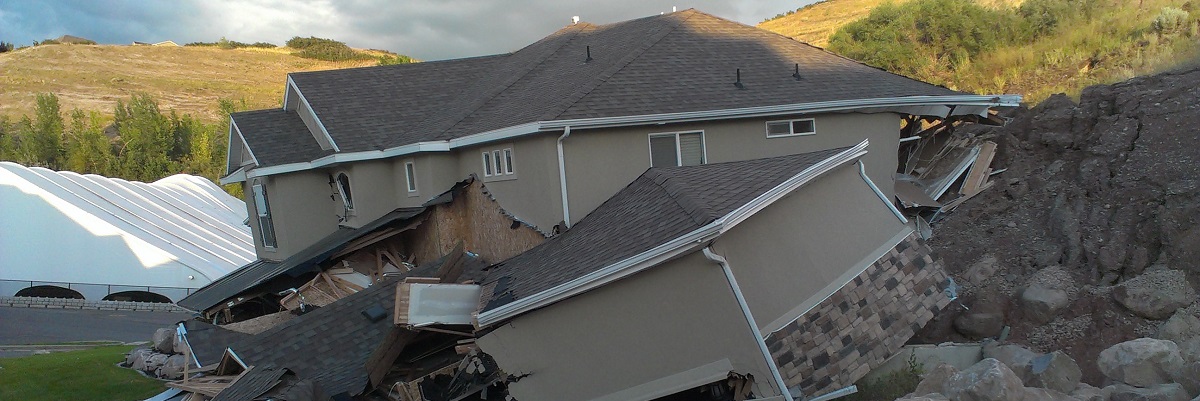Draw a Tree Before During and After a Storm
Landslides: Before, During & After

Landslides can happen anytime in all regions of Canada. The best way to protect yourself and your family in case of a landslide is to follow these steps:
- Learn and be alert to early warning signs.
- Evacuate immediately if landslide is likely. If you cannot evacuate and are inside, curl into a ball and protect your head.
- Prepare for secondary risks such as flooding, downed power lines, and damaged buildings.
Before
- The key to staying safe is to prepare and to have an emergency plan in place.
- Find out if you live in an area where landslides could potentially happen. Landslides may also be referred to as mudslides, debris flows, mudflows or debris avalanches.
- Listen to local news and weather reports for any potential landslide watches and warnings in your area.
- Talk with your family and neighbours about what you would do during a landslide. Identify a safe place to gather.
- Have practice drills with your family, so you know what to do and are prepared.
- Become familiar with the land around where you live and work so that you understand your risk in different situations.
- Avoid actions that could increase instability. For example, don't undercut a steep bank; don't build near the top or base of steep slopes; don't place fill on steep slopes; and don't drain swimming pools or otherwise increase water flow down steep slopes.
- Learn how to recognize the signs of potential imminent landslides. This could include slope cracks, slope bulges, an unusual seepage of water on the slope, sudden changes in stream flow and small rocks falling.
- Watch the patterns of storm water drainage on slopes near your home, especially where runoff water converges.
- Know who to notify if you see these signs. Have municipal emergency contact numbers on hand.
- Have your emergency kit ready
- Make a personalized emergency kit. Families should be prepared to be self-sustaining for at least three days.
- Kits should include practical items such as drinking water, food, cash, and a portable radio. However, they should also include items that are unique to your own families' needs. This could include baby items, medical prescriptions, pet food, etc.
- If you have already dipped into your emergency kit and food supply while staying at home, consider safely getting the supplies to replenish it following your local public health authorities' guidelines for leaving your residence.
- During the COVID-19 pandemic also add hygiene items such as hand sanitizer and non-medical masks to your kit to keep your family safe during an evacuation.
During
- Be prepared to evacuate at a moment's notice.
- If you suspect imminent danger evacuate immediately. Inform affected neighbours if you can, and contact your public works, fire or police department.
- Listen for unusual sounds that might indicate moving debris, such as trees cracking or boulders knocking together.
If indoors:
- Find cover in the part of the building that is the furthest from the approaching landslide.
- Take shelter under a strong table or a bench.
- Hold on firmly and stay put until all movement has stopped.
If outdoors:
Move quickly away from its likely path, keeping clear of embankments, trees, power lines and poles.
Stay away from the landslide area. The slope may experience additional failures for hours to days afterwards.
If you are in your car:
- Watch for collapsed pavement, mud, fallen rocks and other indications of possible debris flow.
After
Continue to take precautions and listen to and follow directions from local authorities.
- Listen to the radio, watch your local news channels, and/or follow your local news outlet and/or emergency officials on social media for further instructions from officials and local leaders.
- Stay away from the slide area until local officials say it is safe to enter.
- Look for and report broken utility lines to appropriate authorities. Reporting potential hazards will get the utilities turned off as quickly as possible, preventing further hazard and injury.
- Check your home's foundation, chimney and surrounding land for damage.
- Replant damaged ground as soon as possible because erosion caused by loss of ground cover can lead to flash flooding.
- If you suspect your home is unsafe, do not enter. Rely on the professionals to clear your home for re-entry, if you are unsure.
- Experiencing a disaster is challenging enough, but during the COVID-19 pandemic it can feel even more difficult. The Red Cross has many resources available to help you navigate these challenging times. You can also find mental and emotional wellbeing resources on the Public Health Agency of Canada, or any provincial/territorial health authority website.
After a Disaster
Recovering after a disaster can be overwhelming. Check out what resources the Red Cross has to offer.
Read more
Get an Emergency Kit
Getting or making a kit is the final step in being ready for any emergency. Find out what you need to put in it.
Read more
Source: https://www.redcross.ca/how-we-help/emergencies-and-disasters-in-canada/types-of-emergencies/landslides
0 Response to "Draw a Tree Before During and After a Storm"
Postar um comentário